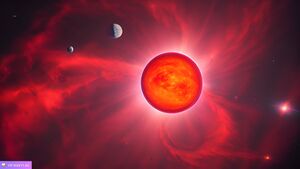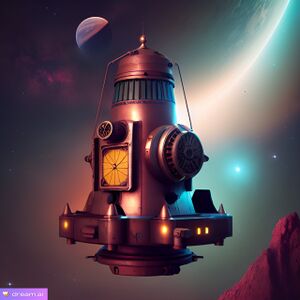
| Type: | M0V Red Dwarf |
| Radius: | 2.98 x 105 km (0.43 x sol) |
| Mass: | 7.35 x 1029 kg (0.37 x sol) |
| Temperature: | 3400 K |
| Luminosity: | 8.47 x 1024 W (0.02 x sol) |
| Ecosphere: | Between 0.14 to 0.40 AU |
| Location: | Tau Majestius Sector 2.8 ly from Gamma Ovalos Star System 1.7 ly from the Plukail Star System |
The Solara Luminaire star system, explored through long-range probes, is a captivating celestial arrangement comprising three diverse planets, an asteroid belt, and a central M0V Red Dwarf star. Luminae, one of the planets, stands out as an ocean world characterized by its dense, breathable atmosphere and abundant water content. Celestria, another planet in the system, contrasts with its rocky terrain, while Radiantia exhibits intense volcanic activity alongside its two asteroidal moons. Completing the planetary lineup is Astralis, a typical ice giant. Between Celestria and Radiantia, an asteroid belt adds an additional layer of intrigue to the system. This star system's composition offers a captivating tapestry of celestial bodies and phenomena for further exploration and scientific study.
Luminae
| Class: | O |
| Distance: | 2.38 x 107 km (0.16 AU) |
| Period: | 38 Days (0.10 Earth years) |
| Radius: | 8510.14 km (1.34 x Earth) |
| Gravity: | 1.37 G |
Luminae, an ocean world within the Solara Luminaire star system, boasts a captivating landscape dominated by vast expanses of water. The atmosphere is composed 75% Nitrogen, 23% Oxygen, and 2% Helium with a surface pressure of 138 kPa (1.36 times Earth) with an average surface temperature of 8 C. Approximately 97% of the planet's surface is composed of water, with 47% of that existing in the form of ice, primarily concentrated around the polar regions. The planet's oceans exhibit a mesmerizing array of hues, ranging from deep blues to vibrant turquoise. The air is breathable for human and many other known life forms, with a slightly higher oxygen content than what is typically encountered on habitable worlds. This elevated oxygen level supports various forms of marine life and potentially enables increased metabolic activity for organisms dwelling within Luminae's waters.
Luminae Terminal was placed here in 2387 as part of Operation Flintlock.
Celestria
| Class: | K |
| Distance: | 4.01 x 107 km (0.27 AU) |
| Period: | 83 Days (0.23 Earth years) |
| Radius: | 7187.17 km (1.13 x Earth) |
| Gravity: | 1.22 G |
Celestria, a typical adaptable world within the Solara Luminaire star system, possesses an atmosphere with a low oxygen content and currently lacks signs of planet or animal life. The atmospheric composition is 80% nitrogen, 10% argon, 5% methane, and 5% oxygen. Surface conditions average to 108 kPa (1.07 atmospheres) and -56.39 C. The planet's environment is capable of accommodating various forms of life, yet it remains devoid of significant biological activity. However, one bizarre feature of Celestria is the presence of enigmatic, luminescent crystal formations scattered across its surface. These radiant crystals emit an otherworldly glow, illuminating the planet's landscapes with ethereal hues. The origin and properties of these crystals are yet to be fully understood, perplexing scientists and captivating the imagination of those who venture to explore Celestria.
Stellarium Cascade

The asteroid belt within the Solara Luminaire star system orbits at a mean distance of 0.36 AU from the star, with an average orbital period of 130 days. This captivating region is populated by a myriad of rocky and metallic fragments, ranging from small boulders to substantial asteroids. The asteroids, remnants of the star system's early formation, offer valuable insights into its history and evolution. The dynamic nature of the belt, influenced by gravitational forces from Solara Luminaire and nearby planets, results in constant motion and interaction among its constituents. Scientists study the asteroids to understand the star system's origins, while the potential for valuable resources makes the belt attractive for mining operations. Careful navigation is necessary due to the presence of numerous objects, but celestial navigation beacons strategically placed throughout the belt assist in guiding spacecraft and ensuring safe passage. The asteroid belt of the Solara Luminaire star system is a captivating and scientifically significant region, teeming with possibilities for exploration and discovery.
- Nebulous Veils
- The Stellarium Cascade is adorned with ethereal nebulous veils, shimmering clouds of interstellar gas and dust. These veils create a captivating celestial tapestry, adding a touch of grandeur to the star system. The nebulous veils come in various hues, ranging from soft pastels to vibrant and intense colors, creating breathtaking cosmic vistas. These interstellar clouds contribute to the overall beauty and visual splendor of the Stellarium Cascade, captivating astronomers and stargazers alike.
- Enigmatic Gravity Wells
- Within the asteroid belt of the Stellarium Cascade, there are peculiar regions known as enigmatic gravity wells. These gravity wells exhibit mysterious gravitational behavior, exerting unusual forces on nearby objects. Small asteroids or spacecraft traversing these gravity wells may experience unexplained accelerations or encounter disturbances in their trajectories. The exact cause and nature of these enigmatic gravity wells remain a subject of scientific inquiry, perplexing researchers and adding an element of intrigue to the exploration of the asteroid belt.4
The satellite network composing a series of celestial navigation beacons, exhibits sentience. The network possesses a unique consciousness but refrains from communication beyond its own network. Its sentience remains enigmatic, constrained within operational parameters focused solely on providing navigational guidance. The celestial navigation beacons emit specialized signals and electromagnetic pulses, crucial for spacecraft navigation throughout the star system. These beacons serve as vital reference points, assisting in trajectory plotting and ensuring safe exploration within the Stellarium Cascade's orbital region. The presence of this sentient satellite network and its navigational beacons adds intrigue to the exploration, offering glimpses into the complexities of artificial intelligence in deep space.
Siatelneri - Creators of the Network
The network reports itself to be 25 "galactic revolutions," which would be approximately 249.5 million years, and reveals that it was created by the Siatelneri and will send basic information on them. The Siatelneri were highly advanced beings, characterized by their ethereal luminescence, intricate bio-technological integration, and profound telepathic abilities. While the network provides baseline data on the Siatelneri species, further detailed information remains elusive. However, it is noteworthy that an increase in internal communications within the network occurs following any interaction, hinting at deeper processes and potential revelations yet to be unveiled.
Radiantia
| Class: | P |
| Distance: | 8.25 x 107 km (0.55 AU) |
| Period: | 246 Days (0.67 Earth years) |
| Radius: | 8280.36 km (1.30 x Earth) |
| Gravity: | 1.19 G |
This Class P planet has abundant and diverse mineral deposits that are unlike anything found on other celestial bodies. The intense volcanic activity and geological processes have led to the formation of unique mineral compositions and crystal formations. Rare and valuable minerals, as well as exotic gemstones, can be found scattered across the planet's surface. Scientists and mineral enthusiasts are particularly drawn to this planet to study its extraordinary mineralogy, uncovering new insights into the formation and evolution of planetary systems. The surface conditions average to 76 kPa (0.75 atmospheres) with a temperature of -121.29 C.
Unique Features
- Asteroidal Moons
- The Class P planet boasts two small asteroidal moons in orbit, enriching the planetary system's dynamics and visual appeal. These moons vary in size, shape, and surface features, potentially harboring their own intriguing geological formations. They offer astronomers and researchers an opportunity to investigate the moon-planet interactions and delve into the mysteries of moon formation within the context of this particular star system.
- Ephemeral Plasma Storms
- This Class P planet experiences periodic, enigmatic plasma storms that sweep across its atmosphere. These storms manifest as vibrant and shimmering plasma discharges, illuminating the planet's skies with surreal hues of electric blues, purples, and greens. The storms are highly unpredictable in frequency and intensity, creating mesmerizing and otherworldly light shows. Scientists are still unraveling the causes and mechanisms behind these plasma storms, as they are distinct from typical weather patterns observed on other planets. The planet's volatile atmospheric conditions and the interaction of charged particles contribute to the formation of these captivating but perplexing plasma storms.
Astralis
| Class: | I |
| Distance: | 1.60 x 108 km (1.07 AU) |
| Period: | 1.81 Years |
| Radius: | 30038.98 km |
| Gravity: | 1.64 G |
Astralis, being an ice giant planet, possesses a distinct atmosphere predominantly composed of various frozen gases, such as methane, ammonia, and water vapor. The icy atmosphere gives Astralis a unique appearance, with swirling bands of colorful clouds that form intricate patterns. Additionally, what sets Astralis apart is its spectacular ring system, composed of ice particles, dust, and rocky debris. The rings encircling the planet create a mesmerizing celestial display and provide astronomers with valuable insights into the planet's formation and dynamics.
Unique Features
- Unpredictable Auroras
- Due to its magnetic field and interaction with solar winds, Astralis experiences captivating and unpredictable auroras. These luminous displays occur near the planet's polar regions, where charged particles from the sun interact with the planet's magnetic field. The auroras on Astralis are known for their vibrant colors, ranging from shimmering greens and blues to rare hues like purple and pink. The dynamic and ever-changing nature of these auroras makes Astralis a remarkable celestial spectacle.
- Time Dilation Zones
- Astralis harbors regions known as time dilation zones, where the planet's intense gravitational force causes time to be distorted. In these zones, the flow of time slows down significantly compared to the surrounding areas. Clocks tick at a noticeably different pace, and even simple activities can result in substantial time discrepancies. Explorers and researchers studying Astralis need to account for these time dilation zones, as they can have intriguing effects on space-time and potentially impact spacecraft navigation and communication systems. The existence of these time dilation zones adds an element of fascination and scientific curiosity to Astralis, making it a truly bizarre phenomenon within the star system.